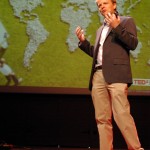Mar19
How Innovation and IT Drive Productivity
Point: Getting maximum benefit from innovation requires new organizational practices
Story: In their book Wired for Innovation, Erik Brynjolfsson and Adam Saunders show how innovation and IT drive productivity growth. Productivity growth explains how cars, for example, went from costing an average of three years of salary a century ago to costing only seven months of salary today. Nor is this gain unique to high-tech products. Even eggs plummeted in their effective price in the last century, dropping from 149 minutes of salary to a mere 5 minutes of salary per dozen eggs. What brought about the productivity improvement? Technology has helped, but it’s not the only factor.
Analyzing both company IT investments and company practices, Brynjolfsson and Saunders found that high IT spending, by itself, didn’t explain high productivity. Some companies spent large sums on IT but seemed to have little to show for it. Highly productive firms, it turns out, also made a set of complementary investments in people and processes. Brynjolfsson and Saunders identified seven key practices:
- Move from analog to digital processes: Don’t just automate paper-based practices. Invest in new ways of doing business enabled by IT (e.g., daily tracking of key performance indicators, enhanced alerts on exceptional events, global collaboration on innovation, etc.)
- Open information access: Give employees all the information they need to accomplish and accelerate their jobs; in contrast, restrictive access impedes information flow and slows down work.
- Empowerment: Give employees the authority to make decisions. Information has no economic value if it doesn’t change a decision. The sooner the information can affect a decision and the sooner the decision gets implemented (i.e., by the frontline employee), the better.
- Performance-based incentives: Reward individuals for their now-measurable contribution to the firm, not just for their years of service, as with traditional seniority-based pay.
- Cohesive corporate culture: Create cultural cohesion and strategic focus so that employees work toward shared goals that matter.
- Recruit the right people: The productivity boost provided by technology depends on the quality of the people who use it, particularly when giving employees more information and authority to make decisions.
- Training: Invest in people by training them to use digital processes, find the right information, make good decisions, and reach their incentive goals.
Action
- Don’t just invest in technology; invest in new processes
- Broaden information access and decision rights
- Invest in training, merit pay, and recruiting
Comments Off on How Innovation and IT Drive ProductivityHow-to, Innovation, Productivity, Strategy










